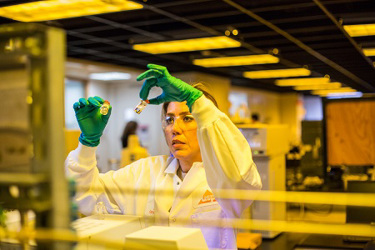USP Targets Advanced Manufacturing For U.S.-Made Generics

By Louis Garguilo, Chief Editor, Outsourced Pharma

“What’s the USP got to do with it?”
That’s what I ask Ronald Piervincenzi, CEO, U.S. Pharmacopeia.
The question is triggered by the announcement of a “strategic alliance” between Phlow Technologies and the USP.
USP scientists will establish and operate a new laboratory at the Virginia Biotechnology Research Park, which includes Virginia Commonwealth University’s Medicines for All Institute.
Phlow is leveraging the advanced manufacturing processes developed at the institute to produce APIs – in the U.S. – for essential medicines in short supply here.
The federal government has contracted Phlow to build resiliency into dozens of those medicines with limited or no domestic manufacturing. (see our recent in-depth series on Phlow.)
The USP, an independent scientific organization of some 200 years, utilizes an internal workforce and collaborates with hundreds of experts globally, in developing quality standards for products, and the technologies to produce them.
The new USP laboratory will provide analytical process development and testing support, and “certify and validate pharmaceutical continuous manufacturing processes resulting in affordable, high-quality, U.S.-manufactured essential medicines.”
“For USP,” Piervincenzi tells me, “this is a positive goal we are excited to be involved with.”
“It’s perfectly rational for countries to want to participate in their own supply chain.”
The federal-Phlow contract, he says, presents a unique opportunity to support faster adoption of continuous manufacturing specifically. That it is part of a large-scale, domestic-generics manufacturing initiative, is icing on the standards cake.
But how can a standard-setter drive supply-chain change, inculcate process innovation, or direct industry dollars?
And how will CDMOs fit into any efforts? We’ll tackle this last question specifically in our second part. Here we’ll get answers for our earlier questions.
USP As Conduit
Phlow sidesteps many U.S.-based generics and continuous manufacturing barriers by starting out with a customer and funding (the Federal Government), the implementing of a large-scale continuous manufacturing platform, and some savvy relationships.
All this, says Piervincenzi, nicely sets up the USP “to partner as we always do, with actual industry practitioners.”

The USP’s own pivot to continuous manufacturing predates the Phlow relationship by about five years, when the organization founded its first internal “research and innovation group” to study standards in areas “not fully understood.”
This group hands off its findings on emerging areas to the USP’s core science group – and vast network of expert volunteers – to create actual standards.
Continuous manufacturing was the first in the research portfolio to proceed.
“It’s the chicken or the egg story,” explains Piervincenzi. “Until we have products, it's hard to have standards. But if you don't have standards, it's a barrier for new products to use a new technology.”
So with Phlow committing to a larger scale, continuous manufacturing platform (developed by Frank Gupton), “the relationship forms a perfect union.”
“What Phlow is attempting is a first,” says Piervincenzi. “No product they work on has ever been commercially produced using continuous manufacturing.”
That's a lot to take on, and then to succeed in convincing the world of quality and business feasibility.
“The USP is there to help. We’ll soon start building out our lab, and we've already started hiring our first 10 scientists to work onsite.”
Four Hills To Conquer
The USP understands from the get-go they face at least four, as Piervincenzi prefers to call them, “inhibitors” to any advanced-technology adoption.
When it comes to using continuous manufacturing for generic products (in the U.S.), those inhibitors are particularly powerful.
1. Length
The first is the longevity of contracts.
For a continuous system, along with costs of implementation, “the financial value returned is zero for the first months,” predicts Piervincenzi, “before rising after that – theoretically throughout the life of a product.”
Therefore, the fiscal return for an innovator drug, with years of patent protection, is built in by that degree of IP protection and “certainty of sustainability.”
Not so for most generic companies that operate under shorter contracts and produce various products.
Or, potentially, if you are a CDMO – again, a subject we’ll return to in due time.
2. Uncertainty
Piervincenzi’s second barrier to advanced technology is regulatory uncertainty.
If you're creating an innovator product, with a longer CMC timeframe and a clinical trial regime, “you might very well take on more risk with new platforms and technologies.”
On the other hand, in the generic industry you are most likely producing various products.
“Introducing a new technology that slows approval processes, and often creates additional uncertainties, is a risk not worth taking.
“Instead, you stay tied to the tried-and-true. This is a barrier for larger-scale generic products as well.”
3. Capability
A third challenge to change is capability – specifically acquiring, training and retaining a skilled workforce.
Piervincenzi says the USP is currently working with Rutgers University and others on workforce training initiatives for continuous manufacturing.
4. Standards
The final inhibitor brings us back to standards.
“Without recognized standards, you have to answer all the quality and regulatory questions yourself,” says Piervincenzi.
“What's the best way to undertake this? How do you know? What's the normal way? What are the parameters I should use? What’s acceptable?
“Having to figure this all out yourself is daunting. Convincing others is even more so – and not just the FDA, but global regulatory bodies potentially not as sophisticated or prepared to understand continuous systems.
“A combination of all this regulatory/quality uncertainty becomes another risk factor for generic companies already fighting low and hard-to-sustain margins.”
But of course, here’s where the USP can make an impact.
And Piervincenzi believes the Phlow relationship provides that opportunity.
Standard Impacts
But exactly how helpful are standards?
The USP did some research to find out.
A 2019 study concluded that drugs with a public quality standard developed by the USP had on average approximately 50% more generic manufacturers compared with medicines without such a standard.
Researchers from Johns Hopkins University, who developed the study, concluded quality standards facilitate pharmaceutical competition, and also reduce prescription drug costs in the U.S.
“We then directly surveyed the drug manufacturers for more insight,” Piervincenzi says.
“They basically replied, ‘Well, that’s not a mystery. With no standard, there’s way more risk, and we don’t bother. The business is already risky enough.’
Piervincenzi adds, “That applies to implementing a new technology as well. In fact, I think it may apply even more.”
Next, we’ll turn to the contract development and manufacturing of generics, and the USP’s thinking on this segment of the industry.
-----
Releated editorial:
Standards For New Technologies: Easy Listening For Outsourcing
You Don’t Know Phlow: The Backstory Of A Misread Biopharma Start-Up
Primal Motivations: Stop Drug Shortages, Start Domestic Supply Chains
